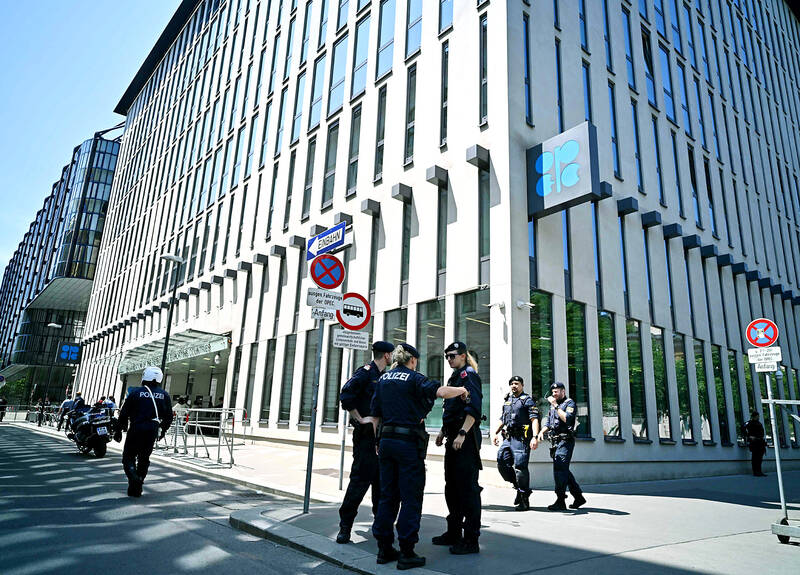There are growing signs that major oil producers led by Saudi Arabia and Russia would consider slashing production in meetings to prop up prices.
The 13-member OPEC is due to consult with 10 other oil-producing nations, including Russia, to review the group’s future output policy.
The in-person OPEC+ meetings were set to begin yesterday in Vienna.

Photo: AFP
Analysts had expected OPEC+ producers to maintain their current policy, but signs emerged on Saturday that staying the course might fall short of stabilizing the oil market.
In April, several OPEC+ members agreed to voluntarily cut production by more than 1 million barrels per day (bpd) — a surprise move which briefly buttressed prices, but failed to bring about lasting recovery.
Oil producers are grappling with falling prices and high market volatility amid the Russian invasion of Ukraine, which has upended economies worldwide.
Most delegations remained tight-lipped or declined to comment on possible policy decisions as they arrived in the Austrian capital for meetings on Saturday.
Analysts were divided over whether heavyweights Riyadh and Moscow would keep the group on course with its current output policy, or further curtail production.
An output cut of 700,000 bpd to 1 million bpd was one of the options being discussed, a source close to the discussions said, adding that nothing was set in stone.
“There was no discussion of production volume today,” Iranian Deputy Oil Minister for International Affairs Amir Hossein Zamaninia said on Saturday, adding that all options remained “on the table” for yesterday’s gathering.
Oil prices have plummeted by about 10 percent since the April cuts were announced, with Brent crude falling close to US$70 per barrel, a level it has not traded below since December 2021.
Traders worry that demand could slump, with concerns about the health of the global economy as the US battles inflation with higher interest rates and China’s post-COVID-19 rebound stutters.
Arriving in Vienna, where OPEC is headquartered, Emirati Minister of Energy Suhail al-Mazrouei said that he expected the outcome of yesterday’s ministerial meeting to “balance the market and ensure we are ready for any challenges in the future.”
It remains to be seen whether Riyadh would convince Moscow to curtail output, as Russia is dependent on oil revenues with its war in Ukraine dragging on and Western sanctions hitting its economy.
Russian Deputy Prime Minister Alexander Novak “sees no need for OPEC+ to change course,” because it would hardly benefit from higher prices, Commerzbank AG commodity analysts said in a research note.
Russia has been shipping its oil to India and China.
Saudi Arabia “does need higher prices to balance its budget,” Commerzbank analysts said, adding that the kingdom’s break-even price is “at a good 80 [US] dollars per barrel.”
Despite recent tensions, OPEC+ top producers “will no doubt be keen to keep the cartel together, as it has more power thanks to the united front it is showing,” they added.

The US dollar was trading at NT$29.7 at 10am today on the Taipei Foreign Exchange, as the New Taiwan dollar gained NT$1.364 from the previous close last week. The NT dollar continued to rise today, after surging 3.07 percent on Friday. After opening at NT$30.91, the NT dollar gained more than NT$1 in just 15 minutes, briefly passing the NT$30 mark. Before the US Department of the Treasury's semi-annual currency report came out, expectations that the NT dollar would keep rising were already building. The NT dollar on Friday closed at NT$31.064, up by NT$0.953 — a 3.07 percent single-day gain. Today,

‘SHORT TERM’: The local currency would likely remain strong in the near term, driven by anticipated US trade pressure, capital inflows and expectations of a US Fed rate cut The US dollar is expected to fall below NT$30 in the near term, as traders anticipate increased pressure from Washington for Taiwan to allow the New Taiwan dollar to appreciate, Cathay United Bank (國泰世華銀行) chief economist Lin Chi-chao (林啟超) said. Following a sharp drop in the greenback against the NT dollar on Friday, Lin told the Central News Agency that the local currency is likely to remain strong in the short term, driven in part by market psychology surrounding anticipated US policy pressure. On Friday, the US dollar fell NT$0.953, or 3.07 percent, closing at NT$31.064 — its lowest level since Jan.

The New Taiwan dollar and Taiwanese stocks surged on signs that trade tensions between the world’s top two economies might start easing and as US tech earnings boosted the outlook of the nation’s semiconductor exports. The NT dollar strengthened as much as 3.8 percent versus the US dollar to 30.815, the biggest intraday gain since January 2011, closing at NT$31.064. The benchmark TAIEX jumped 2.73 percent to outperform the region’s equity gauges. Outlook for global trade improved after China said it is assessing possible trade talks with the US, providing a boost for the nation’s currency and shares. As the NT dollar

The Financial Supervisory Commission (FSC) yesterday met with some of the nation’s largest insurance companies as a skyrocketing New Taiwan dollar piles pressure on their hundreds of billions of dollars in US bond investments. The commission has asked some life insurance firms, among the biggest Asian holders of US debt, to discuss how the rapidly strengthening NT dollar has impacted their operations, people familiar with the matter said. The meeting took place as the NT dollar jumped as much as 5 percent yesterday, its biggest intraday gain in more than three decades. The local currency surged as exporters rushed to